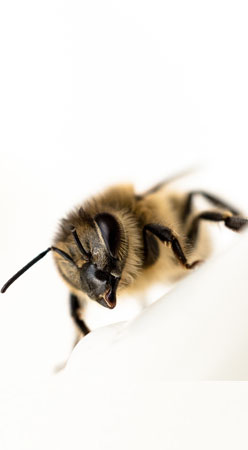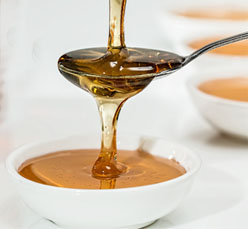


The existence of magnetite or ferrite as part of the composition of the nervous system of bees, made Don Ciro Fernández derive in the study of the magnetic properties of honey; how it can be electromagnetically activated and serve, together with milk, as an element carrying a very high energetic charge that could be introduced by osmosis inside the cells of the body.
The essential characteristics of honey are the inverted reducing sugars, composed of levulose and glucose, high energy carbohydrates. These make up between 65% and 70% of the total components of this natural food. Both sugars are composed of a single molecule (monosaccharides) and their polarized light that passes through a quartz crystal, turns to the left, which is why they are called levogyrus sugars. In addition, honey contains small amounts of Sucrose (polysaccharides) varying from 3% to 8% as a dextrogenic sugar, that is, the plane of light is deflected to the right. Another characteristic of honey is that it is poor in minerals, which reach only 0.22%. Finally, the lack of proteins is also a characteristic, since it reaches a total of almost 0.6%, approximately. In order to produce the desired electro-physical and chemical reactions, the honey must be carefully purified, eliminating any trace of wax, since it is highly insulating and prevents any reaction of molecular transformation. Likewise, the additive added to enrich proteins and minerals must not contain fatty substances or, failing that, these must not exceed 1% of this element, for the same reason of its insulating action. The chosen additive is powdered nonfat milk. This element, enriched with minerals and proteins, has been chosen because of the feasibility of transforming its lactose and lactic acid into monosaccharide reducers of honey, and the hydrolysis that affects its minerals which makes them very assimilable to the human organism, in addition, its proteins are of very good quality.
INTA's analyses, as far as minerals are concerned, showed a percentage presence of 4.66%. In general, the percentage of inorganic elements in the human diet is reduced, except for sodium chloride, which is added artificially. However, there are minerals recognized as "essential" that determine important effects in nutrition, such as Calcium, Iodine and Iron, which need the presence of Copper in order to act. Manganese, Zinc and Cobalt, as components of the vitamin B₁₂ (cyanocobalamin). The Molybdenum, as a constituent of some enzymes. The Fluorine that protects of the formation of cavities and the maintenance of the teeth. The concentrated honey contains almost the totality of the known minerals and they are in soluble state, reason why its absorption and use in the human organism is facilitated. Magnetic Properties of Honey The existence of magnetite or ferrite as part of the composition of the nervous system of bees, made Don Ciro Fernández derive in the study of the magnetic properties of honey; how it can be electromagnetically activated and serve, together with milk, as an element carrying a very high energetic charge that could be introduced by osmosis inside the cells of the body.
The bee, at the moment of discharging the nectar into the cells of the honeycomb, penetrates it with its back down and its legs up and extends it by turning its head from one side to the other. During all this time, its jaws remain in movement and, as the liquid covers its glands, the secretion from these is incorporated into the nectar. This is why the enzymes it attaches to the nectar are of an animal nature. The nectar itself contains invertase, but the bee also produces it in its glands, as well as several others such as catalase, glucose, diastase, invertase, inulase, maltase, etc. The invertase, activated by the catalase gives origin to the inverted monosaccharides, that is to say, to the levulose and the glucose; this last one is taken advantage of and is in the blood as fuel in any place that requires energy. If the reaction is incomplete, it stops in the state of organic acid. Both glucose and levulose, monosaccharides that form honey, do not require previous digestion to be broken down into simpler bodies to be absorbed into the bloodstream (circulatory), which is why it provides rapid energy to the human body with the formation of carbon dioxide and water. beeThis energy is equal to that needed by photosynthesis in the formation of these carbohydrates. In the case of concentrated honey, the process does not stop, and if the concentrate product is wrapped or packed in waterproof cellophane, by means of an automatic sealing machine, the CO2 produced in the ratio is reabsorbed by the mass forcing to continue until its end the reaction started giving a superior quality to the product. From the point of view of human nutrition, it is one of the main contributors of food that represents energy, which the human body needs.
Our ProductIn analyses carried out, 4000 calories per Kg have been verified, that is, 400 calories per 100 grs. of concentrated honey. The items developed in this analytical study and their concentration in the honey treated with R.M.N. elevate it to such high calories making them susceptible to be "burned" in our organism granting a potential energy superior to any known natural food.
I refer to natural foods, because this food is manufactured by a simple magnetic-physical-chemical procedure of the bee honey, to which nutrients have been added also of natural character that produce the activation of the process.
The food has a potential energy that can be transformed and released in a caloric, mechanical and magnetic way, when the combustion takes place. This is the reason why our product is so important, since it contains about 70% of monosaccharides that can be transformed into almost pure energy that can be quickly released into the bloodstream without going through a previous digestive process. However, part of this energy is consumed by the intestinal flora before passing through the cell wall by means of a complicated physical-chemical process. Once the monosaccharides reach the bloodstream, they maintain the cellular activity producing an inverse reaction to that of their photosynthetic formation that gave rise to the glucose and levulose molecule, producing then the transfer of energy when the molecule is oxidized until two stable compounds are formed: carbon dioxide and water. It is convenient to represent that the heat is not a nutrient in the feeding; this one is equivalent to the fuel of an engine that provides energy for its operation, for this reason, considering a loss of energy by functions already explained, before arriving at the sanguineous current, values expressed in calories have been considered, with respect to our concentrated honey product, by gram of gross product.




AMINO ACIDS
Aspartic Acid - Threonine - Serine - Glutamic Acid - Proline - Glycine - Alanine - Cystine - Valine - Methionine - Isoleucine - Leucine - Tyrosine - Phenylalanine - Lysine - Histidine - Arginine. Tryptophan is not detected because it is destroyed in acid hydrolysis
SALES REPRESENTATIVE
Pamela Valdés Ibarra
Diego de Velázquez 2.071, Of. 1.602 Providencia. Santiago +56966074594 pvaldes@panalesdelsur.clSALES REPRESENTATIVE
Sra.Elvira Castillo
Luis Hernandez Parker # 800 Ciudad Jardin Los Heroes Maipu, Santiago 225355777